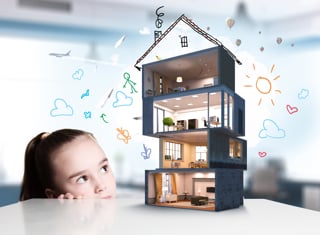Breathe better, learn better – How ventilation systems keep pollen out in schools in Sweden

The majority of schools in Sweden are equipped with mechanical ventilation to provide a good indoor climate for students. Especially in challenging outdoor conditions during pollen season, the well-maintained and filter provided mechanical ventilation captures pollen very effectively. In contrast to Europe, where many countries still rely on natural ventilation, which makes it difficult to control pollen exposure. Is Europe missing out on the benefits of modern mechanical ventilation systems in schools? This is very important question to ask as research show a doubling of allergy affected individuals in the future, extended pollen seasons and significant geographical shifts in allergenic species.
Does Sweden have a ventilation advantage?
Sweden is well established and well known for mechanical ventilation, as about 90% of Swedish buildings use mechanical ventilation, ensuring controlled indoor air quality regardless of outdoor conditions. Well-developed filtering and preventive maintenance routines are standard practice and it is evident that children benefit from clean air in classrooms.
In contrast, most European buildings rely on natural ventilation, which involves opening windows to bring in fresh air in classrooms. That way it is challenging to control pollen, pollution and other outdoor contaminants, disturbing sound aside. Using natural ventilation cannot guarantee good thermal conditions and year-round protection, especially during pollen season.
Mechanical ventilation in Sweden
- Most Swedish buildings use centralised mechanical ventilation with high-efficiency particulate air filters (HEPA or F7-F9 class filters).
- Mechanical ventilation provides controlled supply airflow, and prevents air from entering uncontrollably through infiltration or openings in buildings.
- Systems designed for consistent air changes per hour (ACH) ensure sufficient indoor air quality (IAQ).
- Preventive maintenance and air filter replacement schedules are standardised and regulated.
- The operational evidence shows improved comfort and reduced allergen exposure.
- Sensors for temperature, humidity, CO₂ and airflow balancing are commonly used to optimise indoor air quality.
Is there a missed opportunity?
Europe lacks the broader adoption of mechanical systems and the proven benefits of controlled indoor climate, especially during the airborne allergen season. Considering schools in particular, transitioning to mechanical systems in these buildings would improve the health and comfort of children in their learning environments.
Europe should take action to adopt mechanical ventilation more widely. Includng practical improvements, such as better filtration in schools and public buildings, should be prioritised and implemented.
Facts about pollen
- The size of pollen particles is determined by the plant or tree species that produces it. Smaller pollen grains, typically from weeds, trees, and grasses, can be as small as 2.5 microns and others as large as 200 microns or more.
- A micron (µm) is one-millionth of a meter, a unit of measurement much smaller than a human hair, which is roughly 50-70 microns wide.
- If one can see pollen floating in the air, it is pretty significant, likely around 60 microns or more.
- Properly selected and maintained air filters in mechanical ventilation systems can capture pollen particles (typically 10–100 microns).
What do we know so far?
Using mechanical ventilation in buildings offers many benefits – controlling indoor environment parameters such as temperature, humidity, noise and light quality, and reducing harmful pollutants indoors, originating from biological contaminants such as pollen and other chemical compounds TVOC, and more.
Clean air indoors, even during pollen season, is essential, so children with allergies or asthma can breathe easier indoors. Better air equals better health, learning and well-being for students in schools.
Doubling of affected individuals in the future and prolonged allergy seasons with geographical shifts
- Worldwide, about 400 million people suffer from hay fever, with Europe’s rates reaching up to 40%, while the U.S. is around 30%. And alarming, the numbers of affected people from airborne allergens could likely double in next 50 years due to climate changes [source Quarts: Climate change will double hay fever allergies in Europe over the next 50 years]
- In many countries, the hay fever season is starting earlier, lasting longer and producing higher pollen loads – and there are predictions that rising temperatures will cause a major increase in severity over time. [source The Gueardian: How heat, thunder, smog and new species are making hay fever worse]
- Environmental health scientiests are seeing plants associated with allergies migrating northward and creating geographical shifts, for example towards Poland and Sweden. [source Climate ADAPT: Pollen]
We need to do better
The alarming numbers from many researchers showcase a very grim outlook for people affected by pollen allergies. As allergy seasons are starting earlier and ending later, it brings additional exposure for people of any age. Overall, pollen intensity and allergy potency are increasing, largely affected by the climate changes.
There is a need to install mechanical systems in schools, hospitals and offices, where the health impact is highest. Implementation of preventive maintenance programs can ensure long-term performance of building ventilation systems and offer an allergen-controlled environment indoors for affected individuals.
Sweden has already set the example by using mechanical ventilation in schools for decades. The long-term results show that it works reliably and makes everyday life healthier for children in schools. Knowing that schools have good ventilation can give parents peace of mind that their children are learning in a safe and healthy indoor environment - and they are protected from airborne allergens. And students can focus on learning effectively and enjoy their classrooms.
Reference
Are you interested in learning more about this topic of airborne allergens? Check out our published Update & Insight: 'Airborne allergens extend to an all-year challenge'. And go to the Swegon Air Academy and check knowledge on 'What is affecting us' and more knowledge on children 'At school'.




